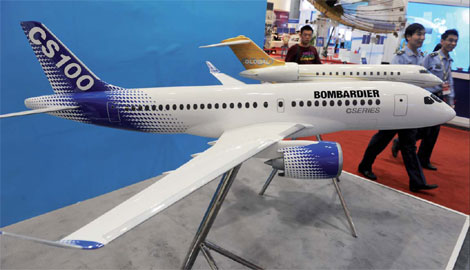Bombardier looks to make up time
Updated: 2011-10-14 08:54
By Wang Chao (China Daily)
|
|||||||||
|
Bombardier's CSeries jet is a departure for the company, with up to 149 seats. Provided to China Daily |
Canadian aircraft maker pins its hope on new plane and a burgeoning market for regional jets
Visitor after visitor to the Beijing Aviation Expo late last month passed by Bombardier's incomplete model of its CSeries jet without so much as a glance. It was simply one of many aircraft models at the show. But for vice-president Benjamin Boehm, it meant much more.
Since Bombardier Inc, the world's third-largest aircraft maker (after Boeing and Airbus), stopped receiving Chinese orders for its Canadair Regional Jets, which are smaller than its soon-to-be-developed CSeries, Bombardier has been looking to make inroads into the nation's growing aircraft market as the domestic demand for regional jets takes off.
It mattered little to Boehm that visitors were ignoring the mockup of the twin-engine, medium-range jet. To Boehm, its debut in China signaled not only a change in strategy; it represented a comeback for the company, whose headquarters is in Montreal, to once again become a force in the Chinese regional jet market.
"There are only 200 regional jets in service in China, but 2,000 in the United States. Since China has a massive land area and a much bigger population, the market will definitely be better than in the US," Boehm says. "So the market has big potential."
The CSeries will have a greater seating capacity than its CRJ Series at up to 149 seats. It is a significant departure for the company, which had previously focused on selling its CRJ line, which has fewer than 100 seats.
But after 2001, when the Chinese government levied a 22-percent tariff on imported small regional jets, the CRJ lost its appeal. It simply became too expensive to sell the CRJ in China. Then last month Bombardier announced it would scale down production of its CRJ due to a slowdown in market demand.
It also announced that the CSeries jets will be eligible for a lower tariff rate from China because the company had cooperated with major Chinese aircraft manufacturers. Boehm expects the move to help Bombardier.
Chinese industry analysts say that by developing the CSeries, Bombardier can fit in more passengers because the CSeries is bigger and can fly longer distances.
"The advantage of CSeries is the low cost of flying because various new technologies have been adopted," Boehm says. "The CSeries can beat any other plane by 20 percent less cost when flying the same distance, which is very appealing to airlines suffering from high oil prices."
Earlier this year the company predicted that China is going to need 2,000 regional planes by 2030. Boehm says right now there are few in China. "In the US, 40 percent of planes are regional, but in China only 10 percent are."
Previously, planes with about 100 seats were either expanded versions of small regional aircraft or trimmed down versions of larger passenger planes. Boehm believes the CSeries will adequately fill in the need for larger regional jets that can handle more passengers.
The company budgeted $3.4 billion (2.5 billion euros) in 2008 to develop the CSeries, which is projected to debut in 2013. The company said it is already seeking orders from customers all over the world.
"Besides, more than 100 airports of all scales are being built across China, which generates a huge potential demand for regional aircraft," Boehm says.
A policy change by the Chinese government will not only benefit Bombardier but its main competitor Embraer, the Brazilian aircraft manufacturer. Earlier this year the Civil Aviation Administration of China issued a policy to waive airport construction fees for 129 regional airports. Seventy-one percent of these airports are small- to medium-scale airports in central and western China where land transportation is problematic.
Liu Jieyin, president of Okay Airways Co Ltd, a private airline in China operating regional aircraft, says that the policy will encourage it to buy more regional planes since operation fees have been waived.
In its cooperative deals with major Chinese aircraft manufacturers, Bombardier has formed partnerships with the Aviation Industry Corp of China (AVIC) and with the Commercial Aircraft Corp of China Ltd. The two Chinese companies will provide key components for the CSeries jets, Bombardier says.
"AVIC Shenyang Aircraft Corp is building parts including the tail and the cabin door," Boehm says. "Almost 15 percent of the plane is made by AVIC."
One of the reasons why Bombardier has faltered in recent years is that it was late in making cooperative deals with Chinese companies, something that is growing more common in the automobile industry. Embraer, for example, established an assembly factory with Chinese partner Harbin Aircraft Industry Co Ltd in 2002, which allowed it to avoid high import tariffs. Embraer's 50-seat E-series regional jets are still being ordered in China. The company also has a sales deal with Hainan Airlines, signed in 2006, for its regional jets.
Gary Scott, the recently retired president of Bombardier, says the company will rebound with its CSeries jets.
"We are already contacting potential customers in China," he said earlier this year.
But Boehm admits Bombardier has to act quickly since China is making its own regional planes.
"The China-made airplane will be a very strong competitor to us. China is now the world's second-largest economy and it should build its own airplane. Today, we don't have local competitors in China, but not necessarily in the future."










